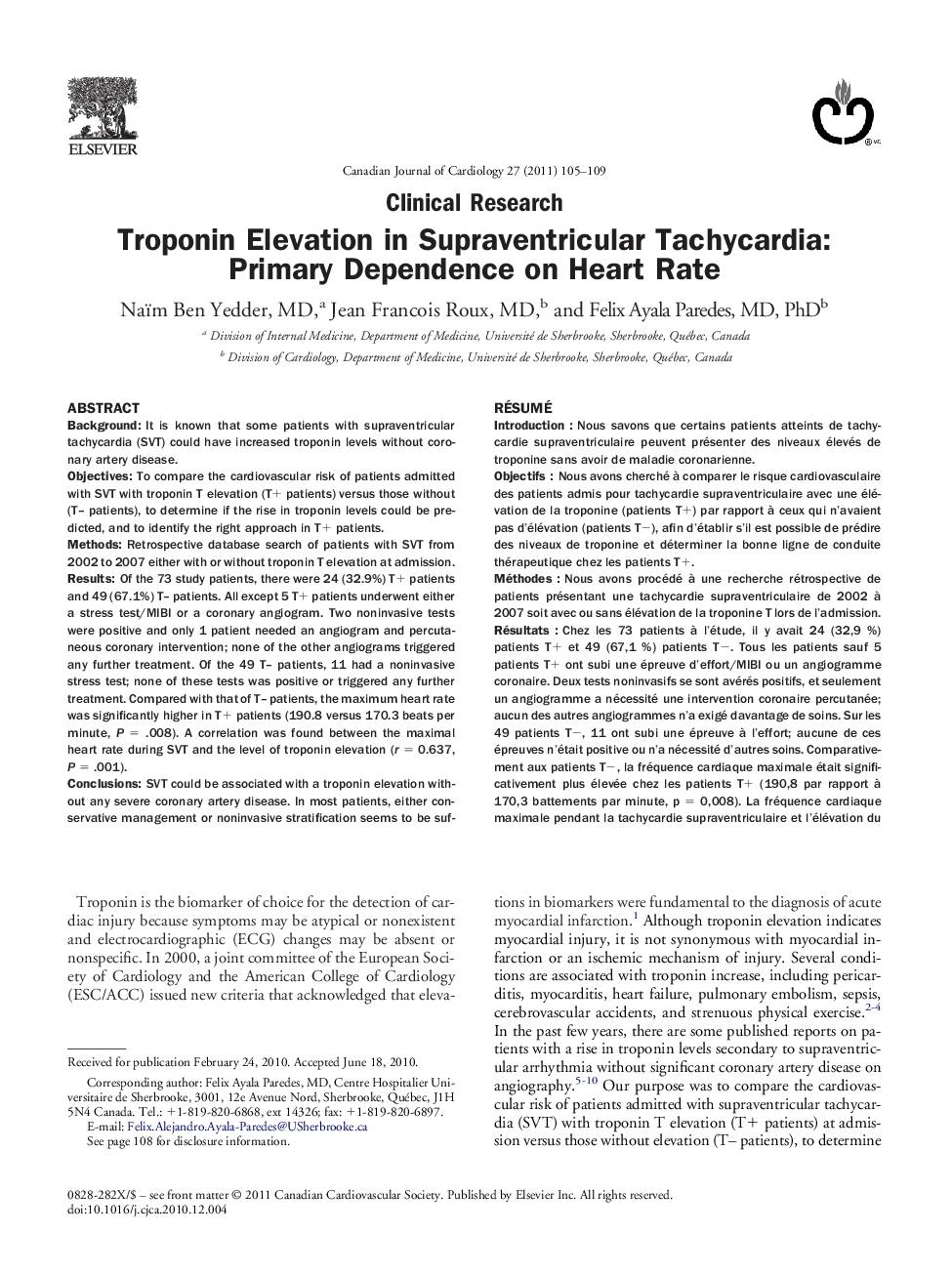| Article ID | Journal | Published Year | Pages | File Type |
|---|---|---|---|---|
| 2732367 | Canadian Journal of Cardiology | 2011 | 5 Pages |
BackgroundIt is known that some patients with supraventricular tachycardia (SVT) could have increased troponin levels without coronary artery disease.ObjectivesTo compare the cardiovascular risk of patients admitted with SVT with troponin T elevation (T+ patients) versus those without (T– patients), to determine if the rise in troponin levels could be predicted, and to identify the right approach in T+ patients.MethodsRetrospective database search of patients with SVT from 2002 to 2007 either with or without troponin T elevation at admission.ResultsOf the 73 study patients, there were 24 (32.9%) T+ patients and 49 (67.1%) T– patients. All except 5 T+ patients underwent either a stress test/MIBI or a coronary angiogram. Two noninvasive tests were positive and only 1 patient needed an angiogram and percutaneous coronary intervention; none of the other angiograms triggered any further treatment. Of the 49 T– patients, 11 had a noninvasive stress test; none of these tests was positive or triggered any further treatment. Compared with that of T– patients, the maximum heart rate was significantly higher in T+ patients (190.8 versus 170.3 beats per minute, P = .008). A correlation was found between the maximal heart rate during SVT and the level of troponin elevation (r = 0.637, P = .001).ConclusionsSVT could be associated with a troponin elevation without any severe coronary artery disease. In most patients, either conservative management or noninvasive stratification seems to be sufficient; an invasive strategy could then be reserved only for high-risk patients who tested positive. The only clinical variable correlated with the troponin rise was a higher maximal heart rate during the SVT episode.
RésuméIntroductionNous savons que certains patients atteints de tachycardie supraventriculaire peuvent présenter des niveaux élevés de troponine sans avoir de maladie coronarienne.ObjectifsNous avons cherché à comparer le risque cardiovasculaire des patients admis pour tachycardie supraventriculaire avec une élévation de la troponine (patients T+) par rapport à ceux qui n'avaient pas d'élévation (patients T−), afin d'établir s'il est possible de prédire des niveaux de troponine et déterminer la bonne ligne de conduite thérapeutique chez les patients T+.MéthodesNous avons procédé à une recherche rétrospective de patients présentant une tachycardie supraventriculaire de 2002 à 2007 soit avec ou sans élévation de la troponine T lors de l'admission.RésultatsChez les 73 patients à l'étude, il y avait 24 (32,9 %) patients T+ et 49 (67,1 %) patients T−. Tous les patients sauf 5 patients T+ ont subi une épreuve d'effort/MIBI ou un angiogramme coronaire. Deux tests noninvasifs se sont avérés positifs, et seulement un angiogramme a nécessité une intervention coronaire percutanée; aucun des autres angiogrammes n'a exigé davantage de soins. Sur les 49 patients T−, 11 ont subi une épreuve à l'effort; aucune de ces épreuves n'était positive ou n'a nécessité d'autres soins. Comparativement aux patients T−, la fréquence cardiaque maximale était significativement plus élevée chez les patients T+ (190,8 par rapport à 170,3 battements par minute, p = 0,008). La fréquence cardiaque maximale pendant la tachycardie supraventriculaire et l'élévation du niveau de troponine ont été corrélées (r = 0,637, p = 0,001).ConclusionsLa tachycardie supraventriculaire est associée à une élévation de la trononine dans l'absence de maladie coronarienne significantive. Chez la plupart des patients, une approche conservatrice ou la stratification noninvasive semble être suffisante; une stratégie invasive pourrait être alors réservée pour les patients à haut risque. La seule variable clinique qui corrèle avec l'augmentation de la troponine est une fréquence cardiaque maximale plus élevée pendant l'épisode de tachycardie supraventriculaire.
